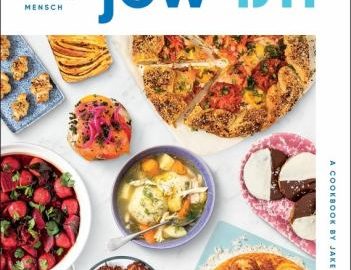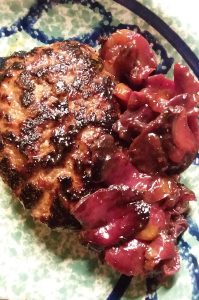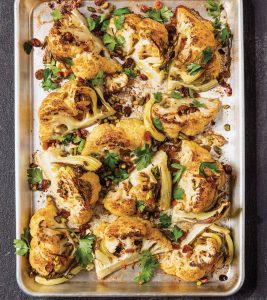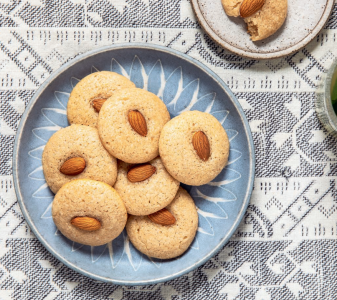
Bibliobites in May: “-Ish” Again
 The melting pot* that is America is never more beautifully expressed than in its foodways. Sure, it’s easy to poke fun at our love of fast food and fried everything; but the variety of cultures represented in our supermarkets and on our plates is astounding. Ingredients that a few years ago might have been looked upon with some puzzlement (“what is that??”) have quickly become standard items in our pantries. Think fish sauce, gochujang, miso, za’atar, tahini, endless varieties of chutney– and that’s just condiments! So, it can certainly be argued that every day, Americans embrace the ish. We may cook Indian-ish or Greek-ish or Thai-ish without a second thought, and our ish may extend to creating dishes that meld familiar foods from our own backgrounds with those of other cultures.
The melting pot* that is America is never more beautifully expressed than in its foodways. Sure, it’s easy to poke fun at our love of fast food and fried everything; but the variety of cultures represented in our supermarkets and on our plates is astounding. Ingredients that a few years ago might have been looked upon with some puzzlement (“what is that??”) have quickly become standard items in our pantries. Think fish sauce, gochujang, miso, za’atar, tahini, endless varieties of chutney– and that’s just condiments! So, it can certainly be argued that every day, Americans embrace the ish. We may cook Indian-ish or Greek-ish or Thai-ish without a second thought, and our ish may extend to creating dishes that meld familiar foods from our own backgrounds with those of other cultures.
This month’s title, Jew-ish by Jake Cohen, perfectly exemplifies how a cultural mashup expresses itself through food. Jews have lived in every corner of the world and have adopted and adapted foods from wherever they have been. If (like me) you grew up in the New York metro area, you are very familiar with the chicken soup-kugel-latke style of Jewish cuisine, but there’s a lot more to it than that, as we discovered once we got into the kitchen. Did we find out that we want to add another ish to our repertoire?
This book grew out of the author’s custom of hosting Shabbat** dinners; accordingly, many recipes are designed to serve 8. This required a bit of math on our parts, since most of us live in smaller households and aren’t hosting dinner parties on a regular basis. But, since we must eat dinner every night, we dove in regardless: four people were intrigued by Iraqi roasted salmon with tomato and lemon. This was a hit for most who tried it; the combination of savory caramelized onions and acidic tomato/lemon topper was the perfect foil for rich salmon.  Lamb chops with crushed grapes and sage was a bit different, and delicious. The sweetly acid roasted grapes were a superb complement to the slightly gamey lamb. Sage and garlic added traditional savory notes. Beef-stuffed eggplant dolmeh, like many stuff-and-roll recipes, required a bit of work to assemble; and unfortunately, the result was “meh! I didn’t like the [acidic] tamarind.” As usual we made plenty of chicken dishes: two people made Persian chicken and celery stew, a bowl of comfort with its tender chicken, warm spices, and an entire bunch of celery! This was a unique and tasty way to use celery; as a bonus, it froze well.
Lamb chops with crushed grapes and sage was a bit different, and delicious. The sweetly acid roasted grapes were a superb complement to the slightly gamey lamb. Sage and garlic added traditional savory notes. Beef-stuffed eggplant dolmeh, like many stuff-and-roll recipes, required a bit of work to assemble; and unfortunately, the result was “meh! I didn’t like the [acidic] tamarind.” As usual we made plenty of chicken dishes: two people made Persian chicken and celery stew, a bowl of comfort with its tender chicken, warm spices, and an entire bunch of celery! This was a unique and tasty way to use celery; as a bonus, it froze well.  Pomegranate-bbq chicken wings were a big hit with their sweet, hot, and tangy sauce. The addictive sauce used mostly standard pantry ingredients; the one outlier was pomegranate molasses. However this tart syrup is now available in supermarkets and is a welcome addition to the ever-expanding condiment lineup! Though the wings are in the appetizer section, one cook used the sauce on chicken legs, which made for an excellent and easy dinner. Leftovers also reheated well. Crispy chicken thighs with tzimmes were just “OK– like sweet and sour chicken.” On the plus side, this was almost a one-dish meal, needing only some rice or potatoes to round it out.
Pomegranate-bbq chicken wings were a big hit with their sweet, hot, and tangy sauce. The addictive sauce used mostly standard pantry ingredients; the one outlier was pomegranate molasses. However this tart syrup is now available in supermarkets and is a welcome addition to the ever-expanding condiment lineup! Though the wings are in the appetizer section, one cook used the sauce on chicken legs, which made for an excellent and easy dinner. Leftovers also reheated well. Crispy chicken thighs with tzimmes were just “OK– like sweet and sour chicken.” On the plus side, this was almost a one-dish meal, needing only some rice or potatoes to round it out.
This title had only a few main-dish choices for vegetarians; one option could be one-pot Persian-ish pasta. This was disappointing, though; the pasta sauce wasn’t really a sauce and wasn’t very flavorful. “I liked the mint…but it needed a real sauce!” Or how about the breakfast-for-dinner option?  Citrus and poppy seed pancakes were “really good” with a “yummy!” lemon-lime topper. This was a “huge” recipe, so either halve it or invite some friends over!
Citrus and poppy seed pancakes were “really good” with a “yummy!” lemon-lime topper. This was a “huge” recipe, so either halve it or invite some friends over!
When it came to sides, we had plenty of choices. Kale tabbouleh was almost a main dish with its foundation of bulgur and butternut squash. It was “very tasty, and it kept well.” Another grain-based dish, fancy mushroom kasha varnishkas, didn’t fare as well; “I just didn’t like the kasha in a pilaf.” But the copious amounts of mushrooms, onions, and butter did help! Baharat smashed potatoes were “really good…a nice blend of spices! I would make again.” The warm spices were nicely complemented by tart sumac and plenty of black pepper. Date-roasted Brussels sprouts were easy and quick, but “stuck horribly to the pan” from the sugary date syrup. Note to author: recommend lining the pan with foil! At least three people made  roasted cauliflower with pistachios and golden raisins. Basic roasted cauliflower was visually and flavorfully enhanced with a simple topper of pistachios, raisins, and parsley, “very good!” Sauteed asparagus with apricot and lemon sounded quite appealing (it was asparagus season, after all). The four cooks who made this deemed it “good” or “OK;” but all said they love asparagus so much that they prefer it roasted plain! Citrusy cumin-roasted carrots were just “OK.” The orange flavor was muted at best; it needed more orange or perhaps some lemon to punch it up?
roasted cauliflower with pistachios and golden raisins. Basic roasted cauliflower was visually and flavorfully enhanced with a simple topper of pistachios, raisins, and parsley, “very good!” Sauteed asparagus with apricot and lemon sounded quite appealing (it was asparagus season, after all). The four cooks who made this deemed it “good” or “OK;” but all said they love asparagus so much that they prefer it roasted plain! Citrusy cumin-roasted carrots were just “OK.” The orange flavor was muted at best; it needed more orange or perhaps some lemon to punch it up?
Once again, desserts got the short end of the stick; several of us thought many recipes looked enticing, but only one actually got made:  chewy Iraqi almond cookies. These were lovely, chewy cookies loaded with almond flavor; they’re gluten-free as they contain only almond flour. Though the recipe called for rose water (a common ingredient in Middle Eastern sweets) our cook left it out– this is an acquired taste for non-natives and some commented that so far, they don’t enjoy a floral note in their baked goods.
chewy Iraqi almond cookies. These were lovely, chewy cookies loaded with almond flavor; they’re gluten-free as they contain only almond flour. Though the recipe called for rose water (a common ingredient in Middle Eastern sweets) our cook left it out– this is an acquired taste for non-natives and some commented that so far, they don’t enjoy a floral note in their baked goods.
As you might surmise from the above, most of us focused on the Sephardic (or Middle Eastern) branch of Jewish cuisine, as opposed to the Ashkenic (or Eastern European) style. Perhaps, since it was springtime, no one was into making the heartier Ashkenazi food, and/or the flavors just sounded less appealing. Though we certainly had our successes, the overall reaction to this title was somewhat tepid. There was lots of “OK” or “pretty good” but not much that was deemed a keeper. A few of the recipes seemed “generic:” challah, tomato-cucumber salad, latkes. However, there’s lots of chatty information about Jewish culture and Shabbat in particular, so this could be of great interest depending on who you are/what you’re interested in learning about. As for the book itself, the photos were nicely done, though there were “not enough.” Are there ever? The font is quite small, which has become something of a trend, one that most of us don’t endorse!
So, though we definitely enjoy the ish factor in our cooking, this didn’t really turn out to be the one for our group. Accordingly, our rating averaged out to a 3.0 (out of a possible 5). That’s a pretty average average!
In June we’ll be sticking closer to home with Heather Atwood’s In Cod We Trust, all about “the celebrated cuisine of coastal Massachusetts.” Copies are available at the main circulation desk or via curbside pickup. Join us to discuss this title at our next meeting on Friday June 30 at 11 AM in the McCarthy Meeting Room. See you there!
*Perhaps it could be more accurately described as a pilaf or a gumbo, where ingredients are cohesive yet distinct? It’s telling that any way you slice it (!), it’s a food metaphor.
**Shabbat: “a day of rest and celebration that begins on Friday at sunset and ends on the following evening.” —chabad.org






